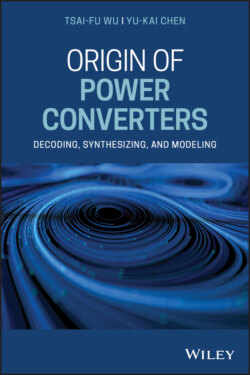Читать книгу Origin of Power Converters - Tsai-Fu Wu - Страница 23
1.6.1 Part I: Decoding and Synthesizing
ОглавлениеPart I includes 11 chapters. They present an introduction, discovery of the original converter, some fundamentals related to power converter synthesis and evolution, illustration of converter synthesis approaches, synthesis of multistage/multilevel converters, extension of hard‐switching converters to soft‐switching ones, and determination of switch‐voltage stresses in the converters. Converters evolved from the original converter are the primary concept developed in this book.
Chapter 2 presents three approaches to creating the origin of power converters, including source–load, proton–neutron–meson, and resonant approaches. In addition, it reviews the properties and typical operation of three conventional PWM converters. Moreover, the conventional topological duality and current source are re‐examined to set up a foundation for later discussions on the development of new PWM converters.
During converter synthesis and evolution, several fundamental circuit theories and principles are used frequently, and they are briefly reviewed and presented in Chapter 3. The fundamentals include DC voltage/current offsetting, capacitor/inductor splitting, DC voltage blocking and filtering, magnetic coupling, DC transformer, switch/diode grafting, and layer scheme.
Chapter 4 first reviews several typical transfer codes, such as step‐down, step‐up, step‐up and step‐down, and ±step‐up and step‐down, from which a proper transfer code derived from the typical codes can be designed for the desired applications. Given a transfer ratio or code, we have to first decode it in terms of the codes of the original converter and its derivatives. Thus, the code configurations and decoding approaches are also presented in Chapter 4.
In Chapter 5, the conventional cell and synchronous switch approaches to developing power converters are first reviewed, from which their limitations are addressed. Then, we describe the principles of the proposed graft switch/diode techniques, and along with the code configurations, syntheses of power converters with the graft switch/diode techniques are illustrated.
Chapter 6 adapts the layer scheme, which is a kind of technique used in growing new plants, to synthesize power converters. We identify the buck and boost families and their DNAs. Moreover, syntheses of new PWM converters have been presented in detail. Furthermore, different converter configurations with identical voltage transfer code are proved to be identical by just changing their capacitor DC offset voltages.
In Chapter 7, we present the syntheses of the well‐known PWM converters, such as voltage‐fed Z‐source, current‐fed Z‐source, quasi‐Z‐source, switched‐capacitor, and switched‐inductor converters. Additionally, the syntheses of PWM converters with the graft switch technique, the converter layer technique, and the fundamentals are also presented.
There are many multistage and multilevel power converters, such as single‐phase converters, three‐phase converters, flywheeling capacitor converters (FCC), Vienna rectifier, neutral‐point clamped converters (NPC), modular multilevel converters (MMC), etc. Systematical syntheses of the converters based on the discussed approaches is presented in Chapter 8. In general, resonant converters, which include quasi‐resonant, resonant, and multi‐resonant converters, are belonged to PWM converters with two half discontinuous operation modes. Their syntheses are also addressed in Chapter 8.
Based on the syntheses of hard‐switching PWM converters, the discussed approaches can be extended to the syntheses of soft‐switching ones, including near‐zero‐voltage switching, near‐zero‐current switching, zero‐voltage switching, and zero‐current switching PWM converters, which are presented in Chapter 9.
Chapter 10 presents the determination of switch‐/diode‐voltage stresses based on the voltage transfer code. This is an additional feature of the code configuration approaches.
Finally, discussions about topological and circuital dualities, identification of new PWM converters based on circuital duality, and analogy of PWM converters to DNA are presented in Chapter 11. A brief conclusion that hopefully no more trial and error is needed in developing power converters is addressed. Moreover, our mindsets in doing research over past 25 years are summarized in a free‐style poem and presented in the end of Part I.
